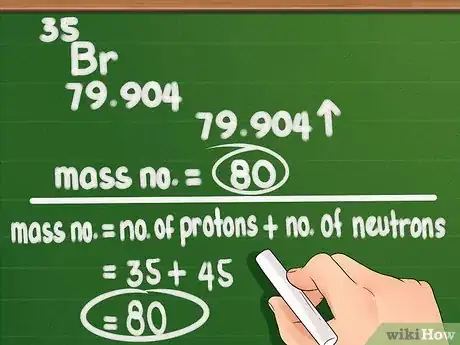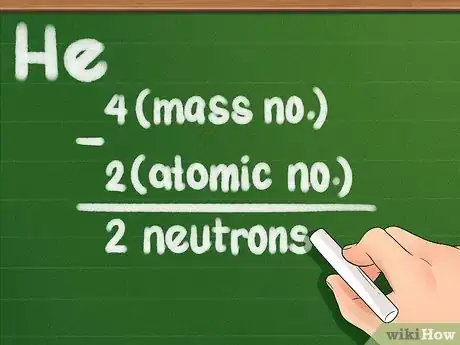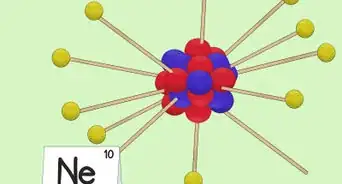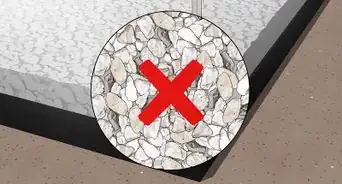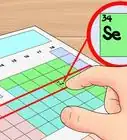This article was co-authored by Bess Ruff, MA. Bess Ruff is a Geography PhD student at Florida State University. She received her MA in Environmental Science and Management from the University of California, Santa Barbara in 2016. She has conducted survey work for marine spatial planning projects in the Caribbean and provided research support as a graduate fellow for the Sustainable Fisheries Group.
There are 8 references cited in this article, which can be found at the bottom of the page.
This article has been viewed 299,859 times.
An element's atomic number is the number of protons in the nucleus of a single atom of that element. The atomic number of an element or isotope cannot change, so you can use the atomic number to help figure out other characteristics, such as the number of electrons and neutrons in an atom.
Steps
Finding the Atomic Number
-
1Find a copy of the periodic table. We've got one here if you don't have one handy. Every single element has a different atomic number, and the elements are ordered on the table according to their atomic numbers. It's either find a copy of the periodic table, or memorize one.[1]
- Most chemistry textbooks have a periodic table printed on the inside cover.
-
2Find the element you're studying. Most periodic tables include the full name of the elements, as well as the chemical symbol (such as Hg for Mercury). If you're having trouble finding it, search online for "chemical symbol" followed by the name of the element.Advertisement
-
3Look for the atomic number. The atomic number is usually in the top left or top right corner of the element's box, but it could be in a different spot. This is always a whole number.
- If the number includes a decimal point, you're probably looking at atomic mass instead.
-
4Confirm based on nearby elements. The periodic table is arranged in order of atomic number. If your element's atomic number is "33," the element to the left should be "32" and the element to the right should have a "34." If this pattern holds true, you have definitely found the atomic number.
- You may see gaps after elements 56 (Barium) and 88 (Radium). There's no actual gap; the elements with those atomic numbers are located in two rows below the rest of the chart. They are only separated like this to fit the periodic table in a more narrow shape.
-
5Understand atomic number. An element's atomic number has a simple definition: the number of protons in one atom of that element.[2] This is the fundamental definition of an element. The number of protons determines the total electric charge of the nucleus, which determines how many electrons the atom can support. Because electrons are responsible for almost all chemical interactions, the atomic number indirectly sets almost all of the element's physical and chemical properties.
- To put it another way, every atom with eight protons is an oxygen atom. Two oxygen atoms might have different numbers of neutrons or (if one is an ion) different numbers of electrons, but they will always have eight protons each.
Finding Related Information
-
1Find the atomic weight. The atomic weight is typically printed below the element name on the periodic table, usually to two or three decimal places. This is the average mass of one atom of the element, weighted to what you would expect to find in nature. This number is in "atomic mass units" (AMU).[3]
- Some scientists prefer the term "relative atomic mass" instead of atomic weight.
-
2Round to the mass number. The mass number is the total number of protons and neutrons in one atom of an element. This is easy to find: just take the atomic weight printed on the periodic table, and round to the nearest whole number.[4]
- This works because neutrons and protons are both very close to 1 AMU, and electrons are very close to 0 AMU. The atomic weight uses precise measurements to get the decimal value, but we're only interested in the whole numbers that tell us the number of protons and neutrons.
- Remember, if you use the atomic weight, you're getting an average for a typical sample. A bromine sample has an average mass number of 80, but as it turns out, a single bromine atom almost always has a mass number of 79 or 81.[5]
-
3Find the number of electrons. Atoms contain the same number of protons and electrons, so these numbers will be the same. Electrons are negatively charged, so they balance out and neutralize the protons, which are positively charged.[6]
- If an atom loses or gains electrons, it becomes an ion, which means that it is an electrically charged atom.
-
4Calculate the number of neutrons. Now you know that atomic number = number of protons, and mass number = number of protons + number of neutrons. To find the number of neutrons in an element, subtract the atomic number from the mass number.[7] Here are a couple example:
- A single helium (He) atom has a mass number of 4 and an atomic number of 2. It must have 4 - 2 = 2 neutrons.
- A sample of silver (Ag) has an average mass number of 108 (based on the periodic table) and an atomic number of 47. On average, each silver atom in the sample has 108 - 47 = 61 neutrons.
-
5Understand isotopes. An isotope is a specific form of an element, with a certain number of neutrons. If a chemistry problem mentions "boron-10" or "10B," it's talking about boron elements with a mass number of 10.[8] Use this mass number instead of the values for "typical" boron.
- Isotopes never change the atomic number. Every isotope of an element has the same number of protons.
Community Q&A
-
QuestionHow do I find the atomic mass number?
 shardaja sandersCommunity AnswerTogether, the number of protons and the number of neutrons determine an element's mass number: mass number = protons + neutrons. If you want to calculate how many neutrons an atom has, you can simply subtract the number of protons, or atomic number, from the mass number.
shardaja sandersCommunity AnswerTogether, the number of protons and the number of neutrons determine an element's mass number: mass number = protons + neutrons. If you want to calculate how many neutrons an atom has, you can simply subtract the number of protons, or atomic number, from the mass number. -
QuestionWhere are the neutrons and protons on a periodic table?
 Community AnswerThe number of protons in one atom of an element is indicated by the atomic number, printed at the top of an element's box on the periodic table. The number of neutrons is not listed on the periodic table. However, you can calculate the number of neutrons in an atom of an element. First, find the atomic weight, listed in the bottom of the element's box. Round this number to the nearest whole number to obtain the mass number. Finally, subtract the atomic number from the mass number.
Community AnswerThe number of protons in one atom of an element is indicated by the atomic number, printed at the top of an element's box on the periodic table. The number of neutrons is not listed on the periodic table. However, you can calculate the number of neutrons in an atom of an element. First, find the atomic weight, listed in the bottom of the element's box. Round this number to the nearest whole number to obtain the mass number. Finally, subtract the atomic number from the mass number. -
QuestionWhat are the protons for gold?
 Community AnswerThe atomic number represents both electrons and protons, so the number of protons for gold is 79.
Community AnswerThe atomic number represents both electrons and protons, so the number of protons for gold is 79.
References
- ↑ https://pubchem.ncbi.nlm.nih.gov/periodic-table/
- ↑ https://www.nde-ed.org/EducationResources/HighSchool/Radiography/atomicmassnumber.htm
- ↑ https://www.khanacademy.org/science/chemistry/atomic-structure-and-properties/introduction-to-the-atom/v/atomic-weight-calculation
- ↑ http://education.jlab.org/qa/pen_number.html
- ↑ http://www.webelements.com/bromine/isotopes.html
- ↑ https://education.jlab.org/qa/pen_number.html
- ↑ https://chemistrytalk.org/protons-neutrons-electrons/
- ↑ https://www.iaea.org/newscenter/news/what-are-isotopes
About This Article
To find the atomic number of an element or isotope, look in a textbook or online to find a copy of the periodic table. Since most periodic tables only list chemical symbols, find a chart that lists the chemical symbol of the element you’re studying, like Ag for Silver or O for Oxygen, then find that symbol on the periodic table. The atomic number is usually in the top left or top right corner of the element’s box, and it should be a whole number. For more tips from our Science reviewer, including how to find the atomic weight or mass number, read on!






